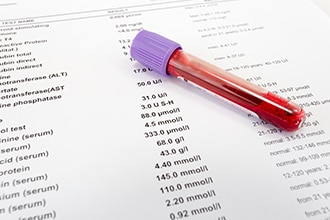Diagnosis of Primary Sclerosing Cholangitis
How do doctors diagnose PSC?
Doctors diagnose primary sclerosing cholangitis (PSC) based on medical and family history, a physical exam, and the results of medical tests.
Medical and family history
The doctor will ask about your symptoms. He or she may also ask whether you have
- a history of inflammatory bowel disease (IBD), particularly ulcerative colitis
- a parent or sibling who has PSC or IBD
- a personal or family history of autoimmune diseases, such as autoimmune hepatitis, type 1 diabetes, celiac disease, and thyroid diseases
Physical exam
Your doctor will examine your body, including your abdomen. He or she will check for
- signs of cirrhosis and liver failure, such as jaundice, which can make the whites of the eyes and skin look yellow
- scratch marks from scratching itchy skin
- signs that the liver and spleen are larger than they should be
- tenderness or pain in the abdomen
What tests do doctors use to diagnose PSC?
Blood tests
 Liver tests can show abnormal liver enzyme levels in your blood.
Liver tests can show abnormal liver enzyme levels in your blood.
A health care professional will take a blood sample from you and send the sample to a lab.
Liver tests can show abnormal levels of liver enzymes and other substances in your blood. Abnormal levels of certain liver enzymes may be a sign your liver or bile ducts are damaged.
Imaging tests
To diagnose PSC, doctors typically order a special imaging test to examine the bile ducts, such as
- magnetic resonance cholangiopancreatography (MRCP), which uses a magnetic resonance imaging (MRI) machine to create pictures of the bile ducts. MRCP is the most common test that doctors use to diagnose PSC.
- endoscopic retrograde cholangiopancreatography (ERCP), which combines upper gastrointestinal (GI) endoscopy and x-rays to examine the bile and pancreatic ducts. Doctors may also use ERCP to treat narrowed bile ducts.
- percutaneous transhepatic cholangiography (PTC), which is an x-ray of the bile ducts. A health care professional inserts a needle through the skin and into the liver to inject a special dye into the bile ducts. The special dye lets a doctor see the bile ducts on the x-ray.
Doctors may also order other imaging tests to check for signs of PSC, other bile duct or liver problems, or complications. These tests include
- ultrasound, which uses a hand-held device, called a transducer, that bounces safe, painless sound waves off organs to create an image of their structure.
- computed tomography (CT) scans, which uses a combination of x-rays and computer technology to create images of the liver.
- elastography, a special test that measures the stiffness of the liver. Increased liver stiffness may be a sign of fibrosis, or scarring.
Liver biopsy
A liver biopsy is generally not needed to diagnose PSC. However, in some cases, doctors may order a liver biopsy to check for signs of other liver diseases, such as autoimmune hepatitis.
During a liver biopsy, a doctor will take small pieces of tissue from the liver. A pathologist will examine the tissue under a microscope.
Colonoscopy
For people who have PSC and haven’t already been diagnosed with IBD, doctors may recommend a colonoscopy to check for IBD. Many people with PSC have mild IBD and don’t have IBD symptoms.
This content is provided as a service of the National Institute of Diabetes and Digestive and Kidney Diseases
(NIDDK), part of the National Institutes of Health. NIDDK translates and disseminates research findings to increase knowledge and understanding about health and disease among patients, health professionals, and the public. Content produced by NIDDK is carefully reviewed by NIDDK scientists and other experts.
